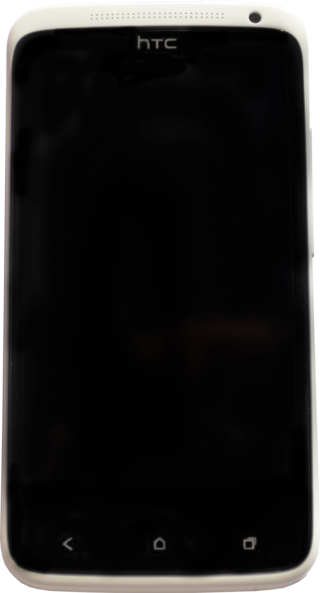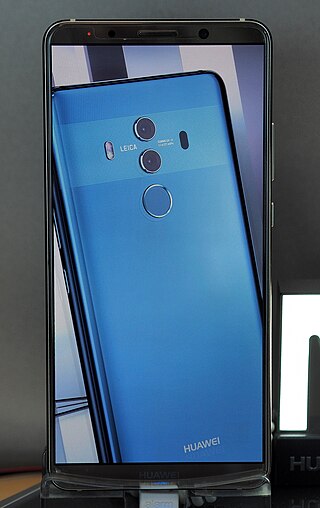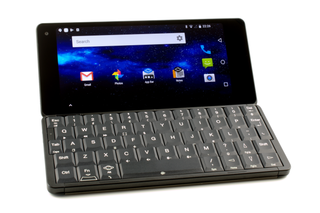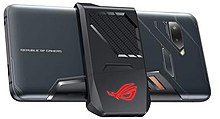
The Samsung Infuse 4G was an Android smartphone that was released by Samsung in May 2011. It has a 1.2 GHz Hummingbird processor with 8–16 GB internal Flash memory, a 4.5 inch 480×800 pixel Super AMOLED Plus capacitive touchscreen display, an 8-megapixel camera and a 1.3-megapixel front-facing camera.

The HTC One X is a touchscreen-based, slate-sized smartphone designed and manufactured by HTC. It was released running Android 4.0.3, with the HTC Sense 4.0 skin. The One X is powered by the NVIDIA Tegra 3 for most international GSM carriers, making this the first HTC phone to be equipped with a quad-core processor, while a variant which is LTE capable is powered by the Qualcomm Snapdragon S4 dual-core 1.5 GHz Krait processor. The One X was announced on February 26, 2012, at the Mobile World Congress and was HTC's sixth flagship product, leading the HTC One series from the time of its release through April 2013, when its successor the HTC One (M7) was announced.
Xiaomi Mi2S, is a high-end, Android smartphone produced by Xiaomi. The device features a quad-core 1.7 GHz Qualcomm Snapdragon 600 as its CPU.

Redmi is a subsidiary company owned by the Chinese electronics company Xiaomi. It was first announced in July 2013 as a budget smartphone line, and became a separate sub-brand of Xiaomi in 2019 with entry-level and mid-range devices, while Xiaomi itself produces upper-range and flagship Xiaomi phones. Redmi phones use Xiaomi's MIUI user interface on top of Android. Models are divided into the entry-level Redmi, the mid-range Redmi Note, and the high-end Redmi K. The unrelated Mi A Android One series is positioned in the same market segment as Redmi devices, despite being part of the upper-range Xiaomi Mi lineup. The most significant difference from other Xiaomi smartphones is that Redmi uses less expensive components, allowing lower prices while retaining good specifications. In August 2014, The Wall Street Journal reported that in the second quarter of the 2014 fiscal year, Xiaomi had a market share of 14% of the China smartphone market; Redmi sales were attributed as a contributing factor toward this ranking.

The Xiaomi Redmi 1 is a smartphone released in July 2013 in China And August 2013 in Global, developed by the Chinese smartphone company Xiaomi Inc. It is the first product of the Redmi series of smartphones. It came with a 4.7-inch 720x1080 IPS screen, a MediaTek MT6589T Quad-core 1.5 GHz Cortex-A7 processor and originally run Android 4.2.2 Jellybean with the MIUI v5 user interface, upgradeable to Android 4.4.2 Kitkat with the MIUI 9 user interface.

The Xiaomi Redmi 1S, code-named armani HM 1S, is a smartphone released in May 2014, developed by the Chinese company Xiaomi Inc. It is a part of the Redmi series of smartphones, and succeeded the Redmi 1. Visually similar to its predecessor, it comes with a 4.7-inch screen, a quad-core 1.6 GHz Cortex-A7 processor and runs Android version 4.3 (Jellybean), bundled with the proprietary MIUI v5 user interface, which can be upgraded to MIUI v9 based on Android 4.4.4 KTU84P.

The Samsung Galaxy A5 (2015) or Samsung Galaxy A5 2015 Edition is an Android smartphone produced by Samsung Electronics. Serving as a premium upper mid-range device, it was introduced on 30 October 2014, along with the smaller and related Samsung Galaxy A3 (2015) and larger Samsung Galaxy A7 (2015) introduced later in January 2015. The Samsung Galaxy A5 (2016) is a successor to the Samsung Galaxy A5 (2015) edition, featuring a revised metal and glass build that debuted with the Galaxy S6.

The Xiaomi Redmi Note 3 is a smartphone developed by Xiaomi Inc. as part of Xiaomi's low-end Redmi smartphone line. It has three variants:
The Xiaomi Redmi Note Prime is a smartphone released in December 2015 in India, developed by the Chinese company Xiaomi Inc. It is a part of the Redmi Note series of smartphones, and succeeded the Redmi Note 4G. Visually similar to its predecessor, it comes with a 5.5-inch screen, a quad-core 1.2 GHz Qualcomm Snapdragon 410 processor and runs MIUI 7 based on Android 4.4, which can be upgraded to MIUI 9 based on.

The Xiaomi Redmi Note 4 is the fourth smartphone under the Redmi Note series developed by Xiaomi Inc. It is a part of Xiaomi's budget Redmi smartphone lineup. It has two variants : The older version sold as Redmi Note 4 is powered by a Deca-core Mediatek MT6797 Helio X20 SOC. The upgraded version, sold both as Redmi Note 4X and Redmi Note 4 is powered by an Octa-core MSM8953 Qualcomm Snapdragon 625 SoC. The Redmi Note 4 was succeeded by Redmi Note 5.

The Huawei Mate 10, Huawei Mate 10 Pro and Huawei Mate 10 Lite are Android smartphones designed and marketed by Huawei as part of the Huawei Mate series. There is also a Mate 10 Porsche design, which has 256Gb of storage but is otherwise identical to the Mate 10 Pro. They were first released on 16 October 2017. Versus the predecessor Mate 9, the Mate 10 pro flagship phone has a faster processor with an integrated neural processing unit, a slightly larger OLED screen (6.0") with a taller 18:9 aspect ratio, a significantly longer battery life and a glass back construction. Chinese and international models are available in dual SIM configuration. It comes with Android 8 and a newer version of Huawei's EMUI interface. All Mate 10 models are unlocked and GSM only. Huawei phones, including the Mate series, are not sold or financed through U.S. carriers due to pressure from U.S. intelligence agencies, though they are available from independent and online retailers.

The Gemini PDA is a personal digital assistant designed by Planet Computers in association with Martin Riddiford, who formerly worked on the Psion Series 5 in the 1990s, and crowdfunded via Indiegogo in 2017. The Gemini bucks the trend of modern smartphones in its screen being primarily used in landscape aspect, and having a keyboard, i.e. taking on the form of a subnotebook.

The Xiaomi Pocophone F1 is a smartphone developed by Xiaomi Inc, a Chinese electronics company based in Beijing. It was announced on 22 August 2018 in New Delhi, India. Though part of Xiaomi's line of mid-range devices, it is equipped with high-end specifications. The device is available globally in limited numbers, except for India where it enjoys wide availability. The Pocophone was often considered to be a flagship model of the Redmi line of 2019, although officially marketed as a separate and distinct model.

The ROG Phone II is an Android gaming smartphone made by Asus as the second generation of ROG smartphone series following the first generation ROG Phone. The ROG Phone II was announced in July 2019 and competes with the Xiaomi Black Shark 2 Pro and ZTE Nubia Red Magic 3s.

Redmi Note 9 is a line of Android-based smartphones as part of the Redmi Note series by Redmi, a sub-brand of Xiaomi Inc.

The ZenFone 6 is a 2019 Android-based smartphone that was manufactured, released, and marketed by Asus. It is the only release in Asus' sixth-generation ZenFone lineup and directly succeeds the ZenFone 5Z. Asus chairman Jonney Shih unveiled the ZenFone 6 on 16 May 2019 in Valencia, Spain, and was released in Spain the following day.
The ROG Phone 3 is an Android gaming smartphone made by Asus as the third generation of ROG smartphone series following the second generation ROG Phone II, announced on 22 July 2020.
ROG Phone 5 is a line of Android gaming smartphones made by Asus as the fourth generation of ROG smartphone series following the third generation ROG Phone 3. It was launched on 10 March 2021.

The Redmi 10 is an Android-based smartphone as part of the Redmi series, a sub-brand of Xiaomi Inc. This device was announced on August 18, 2021.
ROG Phone 6 is a line of Android gaming smartphones made by Asus as the fifth generation of ROG smartphone series following the fourth generation ROG Phone 5. It was launched on July 5, 2022.















